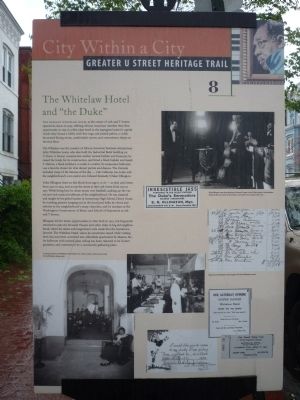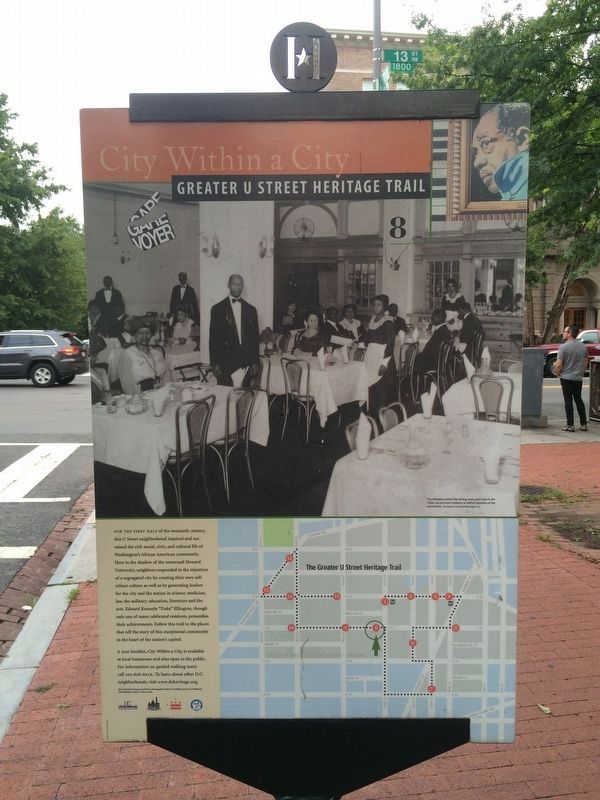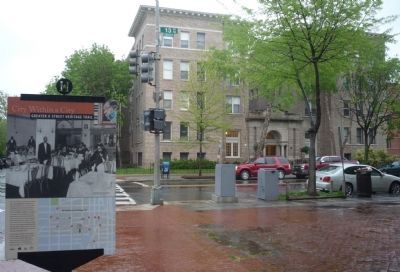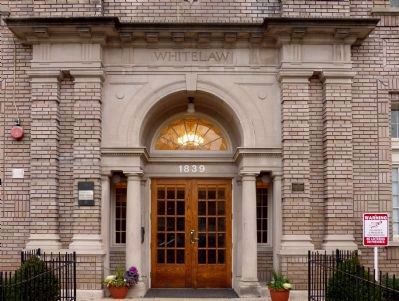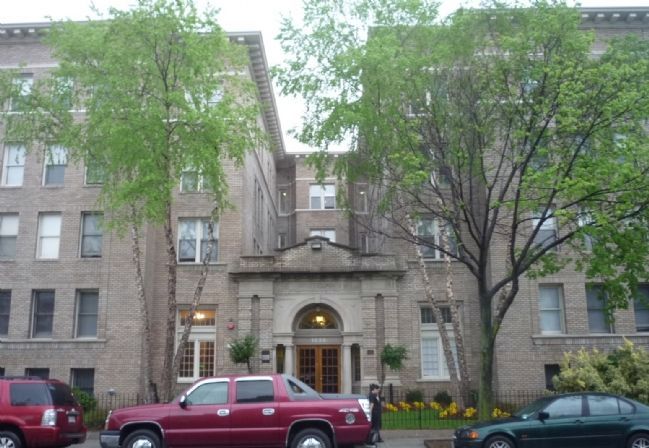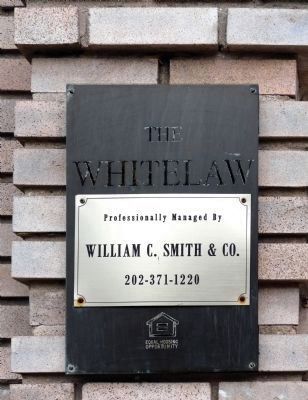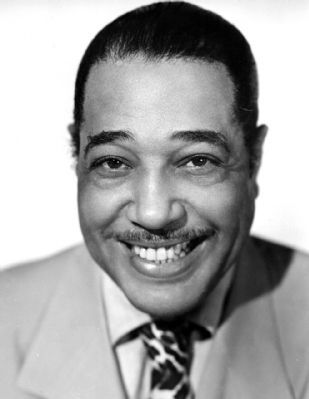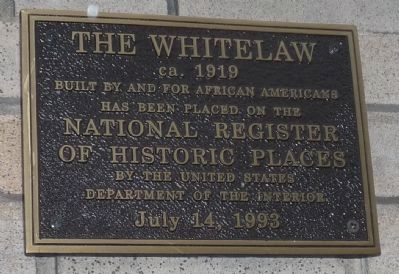U Street Corridor in Northwest Washington in Washington, District of Columbia — The American Northeast (Mid-Atlantic)
The Whitelaw Hotel and “the Duke”
City Within a City
— Greater U Street Heritage Trail —
The elegant Whitelaw Hotel at the corner of 13th and T Street opened its doors in 1919, offering African American travelers their first opportunity to stay in a first-class hotel in the segregated nation's capital. Inside they found a lobby with fine rugs and potted palms, a richly decorated dining room, comfortable rooms, and convenience shops on the first floor.
The Whitelaw was the creation of African America business entrepreneur John Whitelaw Lewis, who also built the Industrial Bank building on U Street. A former construction worker turned builder and financier, he raised the funds for its construction, and hired a Black builder and Isaiah T. Hatton, a Black architect, to make it a reality. Its restaurant/ballroom was a favorite choice for elite dinner parties and dances. The clientele included many of the famous of the day – Cab Calloway, Joe Louis, and the neighborhood’s own native son, Edward Kennedy (Duke) Ellington.
Duke Ellington lived on this block from age 11 to 18 – at 1806 13th Street, from 1910 to 1914, and across the street at 1816 13th Street from 1915 to 1917. While living here he chose music over baseball, soaking up the varied and rich musical traditions of the neighborhood. He was inspired and taught by his gifted teacher at Armstrong High School, Henry Grant, by traveling pianists hanging out in the local pool halls, by choirs and soloists in the neighborhood’s many churches, and by teachers at the Washington Conservatory of Music and School of Expression at 9th and T Streets.
Ellington left for better opportunities in New York in 1923, but frequently returned to play the Howard Theater and other clubs in his old neighborhood, where his talent and magnificent style made him the hometown favorite. The Whitelaw Hotel, where he sometimes stayed while visiting here, has now been converted into affordable apartments by Manna, Inc. Its ballroom with stained glass ceiling has been restored to its former grandeur, and continues to be a community gathering place.
Erected by Cultural Tourism DC. (Marker Number 8.)
Topics and series. This historical marker is listed in these topic lists: African Americans • Entertainment • Notable Buildings. In addition, it is included in the Greater U Street Heritage Trail series list. A significant historical year for this entry is 1806.
Location. 38° 54.931′ N, 77° 1.787′ W. Marker is in Northwest Washington in Washington, District of Columbia. It is in U Street Corridor. Marker is at the intersection of T Street Northwest and 13th Street Northwest, on the right when traveling east on T Street Northwest. Marker is on the sidewalk, on the corner across 13th Street from the Whitelaw building. Touch for map. Marker is at or near this postal address: 1839 13th Street Northwest, Washington DC 20009, United States of America. Touch for directions.
Other nearby markers. At least 8 other markers are within walking distance of this marker. Louise Burrell Miller Residence (about 400 feet away, measured in a direct line); Edward “Duke” Ellington Residence (about 400 feet away); A Home Away From Home (about 500 feet away); Marlon Francisco Morales (about 500 feet away); You Had To Wear a Tie (about 500 feet away); A Magic Place (about 600 feet away); Lincoln Theatre and Lincoln Colonnade (about 600 feet away); Ben's Chili Bowl / Minnehaha Theater (about 600 feet away). Touch for a list and map of all markers in Northwest Washington.
More about this marker.
Photo captions, front:
[Upper right] Duke Ellington, seen here playing the Howard Theater in the 1930s, stayed at the Whitelaw Hotel (Photograph by Robert H. McNeil). At left is an ad for his band about 1920, before he moved to New York (Henry P. Whitehead Collection).
[Right middle] Page from the Whitelaw Hotel register with Duke Ellington’s name [1929]. (The Historical Society of Washington, DC.).
[Lower left] A woman seated in the Whitelaw Hotel lobby in the 1920s. At right, cooks prepare meals for the Whitelaw dining room. (The Historical Society of Washington, D.C.)
[Lower
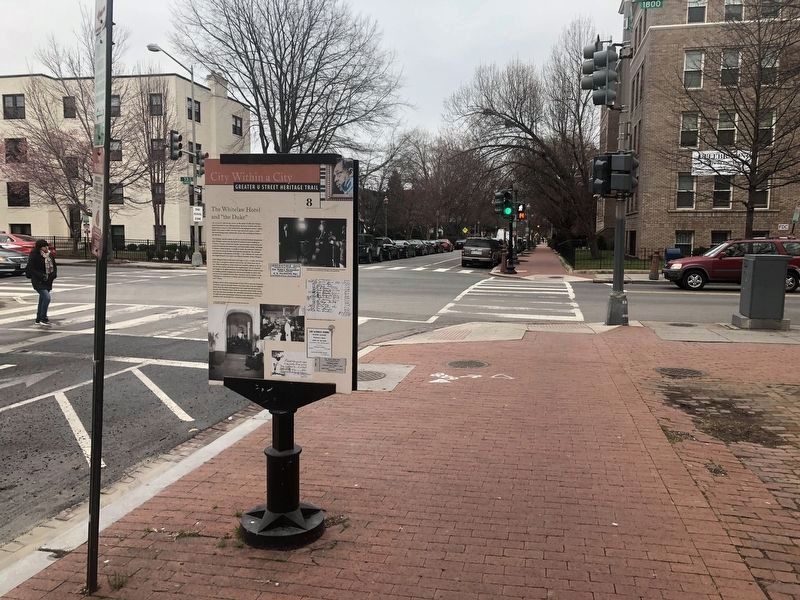
Photographed By Devry Becker Jones (CC0), February 20, 2020
3. The Whitelaw Hotel and “the Duke” Marker
[Lower right] Announcement for “Saturday Evening Supper Dances”, and ticket for “First Annual Spring Frolic” [1941]. (Henry R. Whitehead Collection).
Photo caption on reverse:
The Whitelaw Hotel’s fine dining room, seen here in the 1920s, served residents as well as members of the community. (The Historical Society of Washington, D.C.)
Also see . . . The Whitelaw Hotel. (PDF) National Register Form. (Submitted on December 31, 2014, by Allen C. Browne of Silver Spring, Maryland.)
Credits. This page was last revised on January 30, 2023. It was originally submitted on April 24, 2011, by Richard E. Miller of Oxon Hill, Maryland. This page has been viewed 1,526 times since then and 51 times this year. Last updated on March 7, 2019, by Devry Becker Jones of Washington, District of Columbia. Photos: 1. submitted on April 24, 2011, by Richard E. Miller of Oxon Hill, Maryland. 2. submitted on July 29, 2016, by J. Makali Bruton of Accra, Ghana. 3. submitted on February 20, 2020, by Devry Becker Jones of Washington, District of Columbia. 4. submitted on April 24, 2011, by Richard E. Miller of Oxon Hill, Maryland. 5. submitted on December 31, 2014, by Allen C. Browne of Silver Spring, Maryland. 6. submitted on April 24, 2011, by Richard E. Miller of Oxon Hill, Maryland. 7. submitted on December 31, 2014, by Allen C. Browne of Silver Spring, Maryland. 8. submitted on October 12, 2014, by J. J. Prats of Powell, Ohio. 9. submitted on April 24, 2011, by Richard E. Miller of Oxon Hill, Maryland. • Bill Pfingsten was the editor who published this page.
